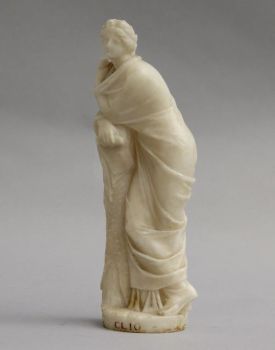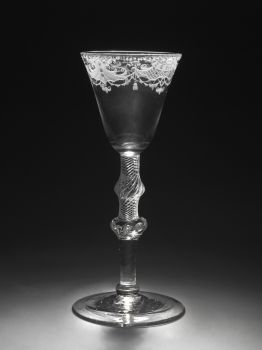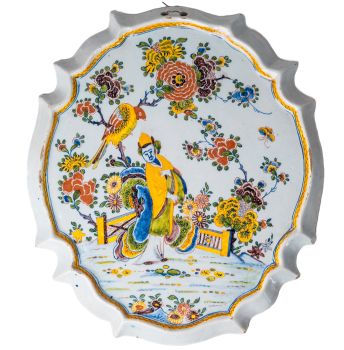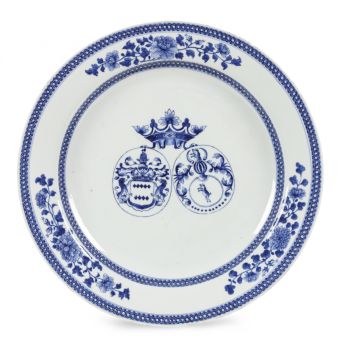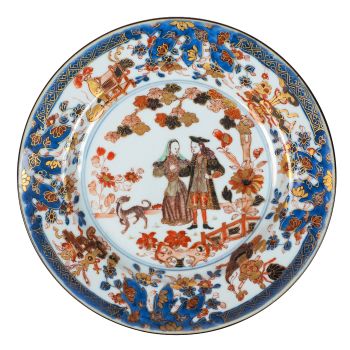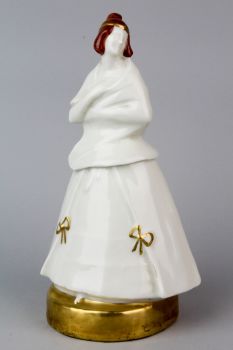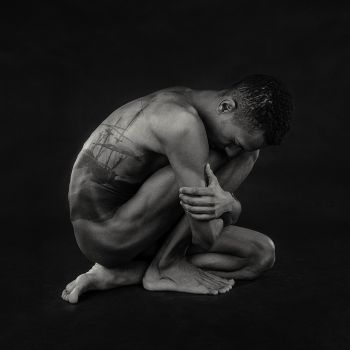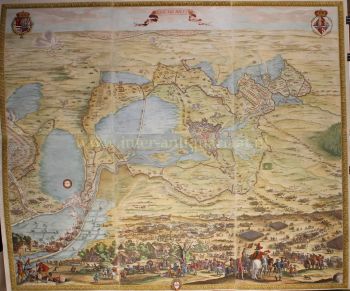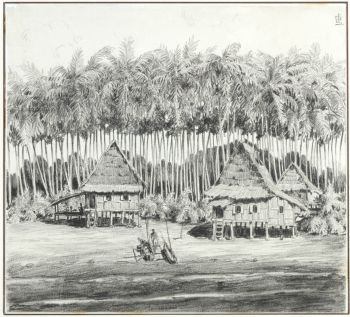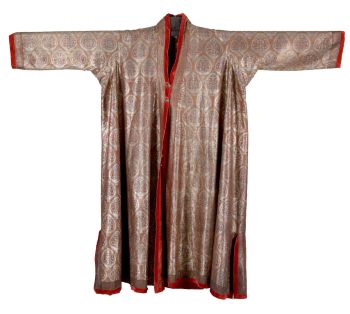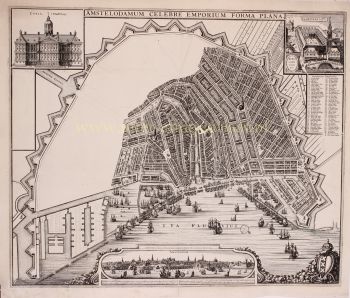EIN PAAR JAPANISCHER BLAU- UND WEISSER ARITA-PORZELLANFLASCHEN MIT DEN INITIALEN VON GENERALGOVERNOR 1700 - 1750
Unbekannter Künstler
PorzellanChinesisches Porzellan
24 cm
Preis auf Anfrage
Zebregs & Röell - Fine Art - Antiques
- Über KunstwerkEarly 18th century
Each with a bulbous body and tapering neck and decorated, in imitation of early Ming style, in underglaze blue with branches of flowering prunus and inside a wreath the initials I:V:H, standing for Joan van Hoorn.
(One restored)
H. 24 cm
Content 2.4 litres
Note:
These bottles exist in various sizes and sometimes have initials of other known or (yet) unknown individuals (See for instance Uit Verre Streken, October 2016, nr. 65 for a bottle with initials L:V:R:, for Lambertus van Riebeeck).
Joan van Hoorn (1653-1711) arrived in Batavia, 12 years old, together with his parents, a bankrupt family but very well connected with the Amsterdam upper-class. From July 1666 till January 1668 Joan, as a thirteen-year-old boy, accompanied his father on a mission to the Emperor of China. Back in Batavia Joan made a swift career in the VOC, not in the least by marrying into the right families. His first marriage in 1691, to Anna Struis, brought him a fortune and the position of Director General and member of the Council of Dutch East India. His second marriage in 1692 was to Susanna van Outhoorn, daughter of Governor-General Willem van Outhoorn, whom he succeeded as Governor-General in 1704. When Susanna died in 1706, Joan married Joanna Maria van Riebeeck, the daughter of his most crucial opponent in the Council and his successor as Governor-General, Abraham van Riebeeck.
Van Hoorn, when Governor-General, was prominent in experimenting with new products for the European market, such as tea, coffee, textiles and ceramics. In 1709 van Hoorn returned to the Netherlands a rich man.
Another Arita bottle with Joan van Hoorn’s initials is in the collection of the Groninger Museum (Rietlinger gift, 1978. 2635). Jan Veenendaal (personal communication) assumes that Van Hoorn gave many of his colleagues, friends and aquaintances larger or smaller Arita bottles with their initials, either in a wreath or simple circle, according to their position within the hierarchy of the VOC. Many of the still unknown initials therefore possibly belong to acquaintances of Joan van Hoorn.
- Über Künstler
Es kann vorkommen, dass ein Künstler oder Hersteller unbekannt ist.
Bei einigen Werken ist nicht zu bestimmen, von wem sie hergestellt wurden, oder sie wurden von (einer Gruppe von) Handwerkern hergestellt. Beispiele sind Statuen aus der Antike, Möbel, Spiegel oder Signaturen, die nicht klar oder lesbar sind, aber auch einige Werke sind überhaupt nicht signiert.
Außerdem finden Sie folgende Beschreibung:
•"Zugeschrieben …." Ihrer Meinung nach wohl zumindest teilweise ein Werk des Künstlers
•„Atelier von ….“ oder „Werkstatt von“ Ihrer Meinung nach eine Arbeit, die im Atelier oder in der Werkstatt des Künstlers, möglicherweise unter seiner Aufsicht, ausgeführt wurde
•„Kreis von ….“ Ihrer Meinung nach ein Werk aus der Zeit des Künstlers, das seinen Einfluss zeigt, eng mit dem Künstler verbunden, aber nicht unbedingt sein Schüler
•"Art von …." oder „Anhänger von ….“ Ihrer Meinung nach eine Arbeit, die im Stil des Künstlers ausgeführt wurde, aber nicht unbedingt von einem Schüler; kann zeitgenössisch oder fast zeitgenössisch sein
•„Art von ….“ Ihrer Meinung nach ein Werk im Stil des Künstlers, aber späteren Datums
•"Nach …." Ihrer Meinung nach eine Kopie (jegliches Datums) eines Werks des Künstlers
• „Unterzeichnet …“, „Datiert …“. oder „Beschriftet“ Ihrer Meinung nach wurde das Werk vom Künstler signiert/datiert/beschriftet. Das Hinzufügen eines Fragezeichens weist auf einen Zweifel hin
• „Mit Unterschrift …“, „Mit Datum …“, „Mit Aufschrift ….“ oder „Trägt Unterschrift/Datum/Beschriftung“ ihrer Meinung nach die Unterschrift/Datum/Beschriftung von jemand anderem als dem Künstler hinzugefügt wurde
Sind Sie daran interessiert, dieses Kunstwerk zu kaufen?
Artwork details
Related artworks
Unbekannter Künstler
Set Franse Empire Pendules / Empire Lectura penduleearly 19th
Preis auf AnfrageKuipers Kunst & Antiek
Unbekannter Künstler
Japanese art deco lacquervase with Scarab beetle motif1920 - 1950
Preis auf AnfrageDille Art
Unbekannter Künstler
Series of 6 Chinese cups and saucers (Yongzheng period)1722 - 1735
Preis auf AnfrageKuipers Kunst & Antiek
1 - 4 / 12- 1 - 4 / 5
- 1 - 4 / 24
Shiba Kokan
Gemälde eines Fantasy-Holländersearly 19th
Preis auf AnfrageZebregs & Röell - Fine Art - Antiques
Unbekannter Künstler
Holländer in Miniatur18th century
Preis auf AnfrageZebregs & Röell - Fine Art - Antiques
Cornelis Anthonisz Theunissen
SEHR SELTENE ERSTE GEDRUCKTE KARTE VON AMSTERDAM, EINER STADT AUF DEM AUFSTIEG1544
€ 175.000Inter-Antiquariaat Mefferdt & De Jonge
 Kuratiert von
Kuratiert vonDanny Bree
Unbekannter Künstler
Holländer in Miniatur (Netsuke)1700 - 1900
Preis auf AnfrageZebregs & Röell - Fine Art - Antiques
1 - 4 / 24Unbekannter Künstler
Series of 6 Chinese cups and saucers (Yongzheng period)1722 - 1735
Preis auf AnfrageKuipers Kunst & Antiek
1 - 4 / 24Unbekannter Künstler
Zwei Studienporträts von Mas Marco Kartodikromo1900 - 1950
Preis auf AnfrageZebregs & Röell - Fine Art - Antiques
Wolfgang Hugo Rheinhold
“Eritis sicut Deus”1900 - 1950
Preis auf AnfrageZebregs & Röell - Fine Art - Antiques
1 - 4 / 12



